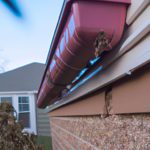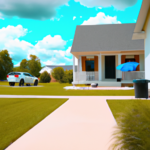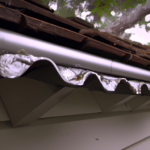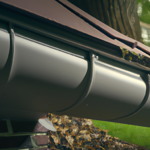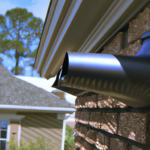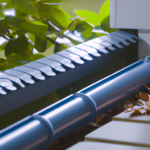-
Table of Contents
- Introduction
- Maximizing Water Efficiency in Your Landscaping with Gutters
- Creating a Beautiful Rain Garden with Proper Gutter Installation
- Incorporating Rain Chains into Your Landscape Design for Aesthetic and Functional Appeal
- The Benefits of Water Features in Your Landscaping and How Gutters Can Help
- Protecting Your Landscaping Investment with High-Quality Gutter Systems
- Q&A
- Conclusion
“Enhance your outdoor space with functional and beautiful gutter solutions.”
Introduction
Gutters and landscaping can go hand in hand when it comes to designing an outdoor space. By incorporating gutters into your landscaping design, you can not only enhance the aesthetic appeal of your property but also improve its functionality. One way to do this is by using rain chains or creating a rain garden. In this article, we will explore these options and provide tips on how to incorporate gutters into your landscaping design.
Maximizing Water Efficiency in Your Landscaping with Gutters
Gutters are an essential part of any home’s exterior, but they can also be a valuable addition to your landscaping design. By incorporating gutters into your landscaping, you can maximize water efficiency and create a beautiful, sustainable outdoor space.
One way to incorporate gutters into your landscaping is by using rain chains. rain chains are a decorative alternative to traditional downspouts that guide rainwater from your gutters to the ground. They come in a variety of styles and materials, such as copper, brass, and aluminum, and can add a unique touch to your landscaping design.
rain chains work by allowing rainwater to flow down a series of cups or links, creating a soothing sound as the water cascades to the ground. They can be attached to your existing gutters or installed as a standalone feature, and can be used to direct water into a rain barrel or a rain garden.
Another way to incorporate gutters into your landscaping is by creating a rain garden. A rain garden is a shallow depression in your yard that is designed to capture and absorb rainwater runoff. By planting native plants and flowers in the rain garden, you can create a beautiful, low-maintenance landscape feature that also helps to filter pollutants from the water.
To create a rain garden, you will need to choose a location that is at least 10 feet away from your home’s foundation and any septic systems. The area should also receive at least six hours of sunlight per day and have well-draining soil. Once you have selected a location, you can dig a shallow depression and add a layer of gravel or sand to improve drainage. Then, you can add a layer of compost and topsoil before planting your chosen plants and flowers.
By incorporating gutters into your rain garden design, you can direct rainwater from your roof into the garden, providing a natural source of water for your plants. You can also use a rain barrel to collect rainwater from your gutters and use it to water your garden during dry spells.
In addition to rain chains and rain gardens, there are other ways to maximize water efficiency in your landscaping with gutters. For example, you can install a drip irrigation system that delivers water directly to your plants’ roots, reducing water waste and promoting healthy growth. You can also use permeable paving materials, such as gravel or permeable concrete, to allow rainwater to soak into the ground instead of running off into storm drains.
Overall, incorporating gutters into your landscaping design can help you create a sustainable, water-efficient outdoor space that is both beautiful and functional. Whether you choose to use rain chains, create a rain garden, or explore other water-saving options, there are many ways to make the most of your gutters and enhance your landscaping. So why not start exploring your options today and see how you can create a more sustainable, beautiful outdoor space?
Creating a Beautiful Rain Garden with Proper Gutter Installation
Gutters and Landscaping: Learn how to incorporate gutters into your landscaping design, such as by using rain chains or creating a rain garden.
When it comes to landscaping, most people think of plants, flowers, and trees. However, there is another important element that can enhance the beauty of your outdoor space: gutters. Gutters are not only functional, but they can also be aesthetically pleasing if incorporated into your landscaping design properly.
One way to incorporate gutters into your landscaping design is by using rain chains. rain chains are a decorative alternative to traditional downspouts. They are made of a series of cups or links that guide the water from the gutter to the ground. rain chains come in a variety of styles and materials, such as copper, brass, and aluminum. They can add a unique touch to your landscaping design and create a soothing sound as the water flows through them.
Another way to incorporate gutters into your landscaping design is by creating a rain garden. A rain garden is a shallow depression in the ground that is designed to capture and absorb rainwater. It is typically planted with native plants and flowers that can tolerate both wet and dry conditions. A rain garden can help reduce the amount of water that runs off your property and into storm drains, which can help prevent erosion and pollution.
To create a rain garden, you will need to install gutters and downspouts that direct the water to the garden. The size of the rain garden will depend on the amount of rainfall your area receives and the size of your roof. You will also need to choose the right plants for your rain garden. Native plants are the best choice because they are adapted to the local climate and soil conditions. They also provide habitat for birds, butterflies, and other wildlife.
Proper gutter installation is essential for creating a beautiful rain garden. The gutters should be installed at the correct angle to ensure that the water flows smoothly to the downspouts. The downspouts should be directed away from the foundation of your home and towards the rain garden. You may also need to install a filter or screen to prevent debris from clogging the gutters and downspouts.
Once your rain garden is installed, it will require some maintenance. You will need to water the plants during dry spells and remove any weeds or debris that may accumulate in the garden. However, a well-designed rain garden should require less maintenance than a traditional lawn or garden.
In conclusion, incorporating gutters into your landscaping design can enhance the beauty of your outdoor space while also providing functional benefits. rain chains and rain gardens are two ways to incorporate gutters into your landscaping design. A rain garden can help reduce the amount of water that runs off your property and into storm drains, which can help prevent erosion and pollution. Proper gutter installation is essential for creating a beautiful rain garden. With the right plants and maintenance, a rain garden can provide a beautiful and sustainable addition to your landscaping design.
Incorporating Rain Chains into Your Landscape Design for Aesthetic and Functional Appeal

Gutters are an essential part of any home’s exterior, but they don’t have to be an eyesore. In fact, gutters can be incorporated into your landscaping design to add both aesthetic and functional appeal. One way to do this is by using rain chains.
rain chains are a beautiful alternative to traditional downspouts. They are typically made of metal or ceramic and feature a series of cups or links that guide rainwater from the roof to the ground. As the water flows down the chain, it creates a soothing sound that can be quite relaxing.
rain chains come in a variety of styles and designs, so you can choose one that complements your home’s architecture and landscaping. For example, if you have a modern home with clean lines, you might opt for a sleek, minimalist rain chain. If you have a more traditional home with lots of character, you might choose a more ornate rain chain with intricate details.
In addition to their aesthetic appeal, rain chains also serve a functional purpose. They help to direct rainwater away from your home’s foundation, which can prevent water damage and erosion. Plus, they can be used to create a beautiful water feature in your yard. Simply place a large basin or container at the bottom of the rain chain to catch the water and create a mini pond or fountain.
Another way to incorporate gutters into your landscaping design is by creating a rain garden. A rain garden is a shallow depression in your yard that is designed to capture and absorb rainwater. It is typically planted with native plants and grasses that can tolerate both wet and dry conditions.
rain gardens are beneficial for several reasons. First, they help to reduce stormwater runoff, which can prevent flooding and erosion. Second, they provide habitat for birds, butterflies, and other wildlife. Finally, they can add beauty and interest to your yard.
To create a rain garden, start by selecting a location that is at least 10 feet away from your home’s foundation. This will ensure that the water is directed away from your home. Next, dig a shallow depression that is about 6 inches deep. Fill the depression with a mixture of sand, compost, and topsoil. Finally, plant native plants and grasses that can tolerate both wet and dry conditions.
In conclusion, gutters don’t have to be an eyesore. By incorporating rain chains or creating a rain garden, you can add both aesthetic and functional appeal to your landscaping design. rain chains are a beautiful alternative to traditional downspouts, while rain gardens can help to reduce stormwater runoff and provide habitat for wildlife. So why not give your gutters a makeover and create a beautiful and functional landscape at the same time?
The Benefits of Water Features in Your Landscaping and How Gutters Can Help
When it comes to landscaping, water features are a popular addition that can add both beauty and functionality to your outdoor space. From fountains to ponds, there are many options to choose from. However, one often overlooked aspect of water features is the role that gutters can play in their design.
Gutters are typically thought of as a practical necessity for any home, but they can also be incorporated into your landscaping design in creative ways. One popular option is the use of rain chains. These decorative chains are hung from the gutter downspout and allow rainwater to flow down them, creating a soothing sound as it falls into a basin or other water feature.
rain chains come in a variety of styles and materials, from copper to ceramic, and can be customized to fit the aesthetic of your landscaping. They are also a great alternative to traditional downspouts, which can be unsightly and detract from the overall look of your home.
Another way to incorporate gutters into your landscaping is by creating a rain garden. A rain garden is a shallow depression in your yard that is designed to collect and absorb rainwater runoff. By planting native plants and flowers in the rain garden, you can create a beautiful and functional addition to your landscaping.
Gutters play a crucial role in the success of a rain garden, as they help to direct water to the garden and prevent erosion. By installing a rain barrel at the end of your gutter system, you can collect rainwater to use for watering your plants and reduce your reliance on municipal water sources.
In addition to their aesthetic benefits, incorporating gutters into your landscaping can also help to prevent water damage to your home. By directing rainwater away from your foundation and landscaping, gutters can prevent erosion and water damage to your home’s exterior.
When designing your landscaping with gutters in mind, it’s important to consider the placement and size of your gutters. Gutters that are too small or improperly placed can lead to water damage and erosion, while gutters that are too large can be unsightly and detract from the overall look of your home.
It’s also important to consider the maintenance of your gutters when incorporating them into your landscaping. Regular cleaning and maintenance of your gutters is crucial to ensure that they are functioning properly and directing water away from your home.
In conclusion, incorporating gutters into your landscaping design can add both beauty and functionality to your outdoor space. From rain chains to rain gardens, there are many creative ways to incorporate gutters into your landscaping. By considering the placement, size, and maintenance of your gutters, you can ensure that they are functioning properly and helping to prevent water damage to your home. So why not add a water feature to your landscaping and see how gutters can help enhance its beauty and functionality?
Protecting Your Landscaping Investment with High-Quality Gutter Systems
When it comes to landscaping, homeowners often focus on the plants, flowers, and hardscaping elements like patios and walkways. However, one important aspect that is often overlooked is the role of gutters in protecting your landscaping investment. Gutters are an essential part of any home’s exterior, as they help to direct rainwater away from the foundation and prevent water damage. But did you know that gutters can also be incorporated into your landscaping design?
One way to incorporate gutters into your landscaping is by using rain chains. rain chains are a decorative alternative to traditional downspouts, and they can add a unique touch to your home’s exterior. rain chains are typically made of metal or ceramic and are designed to guide rainwater from the roof to the ground in a visually appealing way. They come in a variety of styles and designs, from simple chains to intricate shapes like flowers or animals.
Another way to incorporate gutters into your landscaping is by creating a rain garden. A rain garden is a shallow depression in the ground that is designed to capture and absorb rainwater. By directing the water from your gutters into a rain garden, you can help to prevent erosion and runoff, while also providing a habitat for plants and wildlife. rain gardens can be designed to fit any size or shape of yard, and they can be planted with a variety of native plants that are adapted to your local climate.
When designing your rain garden, it’s important to choose plants that are suited to the amount of water that will be present. Plants that are adapted to wet conditions, such as ferns, sedges, and swamp milkweed, are ideal for rain gardens. These plants can help to filter pollutants from the water and provide habitat for beneficial insects and birds.
In addition to rain chains and rain gardens, there are other ways to incorporate gutters into your landscaping design. For example, you can use gutters to collect rainwater for use in your garden. By installing a rain barrel at the end of your gutter system, you can collect and store rainwater for use during dry periods. This can help to reduce your water bill and conserve water resources.
When it comes to gutters, it’s important to choose high-quality materials that will last for years to come. Aluminum gutters are a popular choice, as they are lightweight, durable, and resistant to rust and corrosion. Copper gutters are another option, as they are highly decorative and can add a touch of elegance to your home’s exterior. No matter what type of gutter system you choose, it’s important to have it installed by a professional to ensure that it is properly aligned and functioning correctly.
In conclusion, gutters are an essential part of any home’s exterior, and they can also be incorporated into your landscaping design. By using rain chains, creating a rain garden, or collecting rainwater for use in your garden, you can help to protect your landscaping investment and conserve water resources. When choosing a gutter system, be sure to choose high-quality materials and have it installed by a professional to ensure that it is functioning correctly. With a little creativity and planning, you can create a beautiful and functional landscape that is both sustainable and visually appealing.
Q&A
1. What is a rain chain?
A rain chain is a decorative alternative to a downspout that guides rainwater from the roof to the ground in a visually appealing way.
2. How can gutters be incorporated into landscaping design?
Gutters can be hidden behind plants or incorporated into the design of a rain garden to help manage water runoff and prevent erosion.
3. What is a rain garden?
A rain garden is a landscaped area designed to capture and absorb rainwater runoff, typically planted with native vegetation that can tolerate both wet and dry conditions.
4. Why is it important to manage water runoff in landscaping?
Managing water runoff helps prevent erosion, protects water quality by reducing the amount of pollutants that enter waterways, and can even help conserve water by capturing and reusing rainwater.
5. What are some other ways to incorporate sustainable practices into landscaping design?
Other sustainable landscaping practices include using native plants, reducing the amount of lawn area, composting yard waste, and using organic fertilizers and pest control methods.
Conclusion
Conclusion: Incorporating gutters into your landscaping design can not only enhance the aesthetic appeal of your property but also help in managing rainwater effectively. By using rain chains or creating a rain garden, you can make your gutters a part of your landscape design and contribute to sustainable water management practices.
